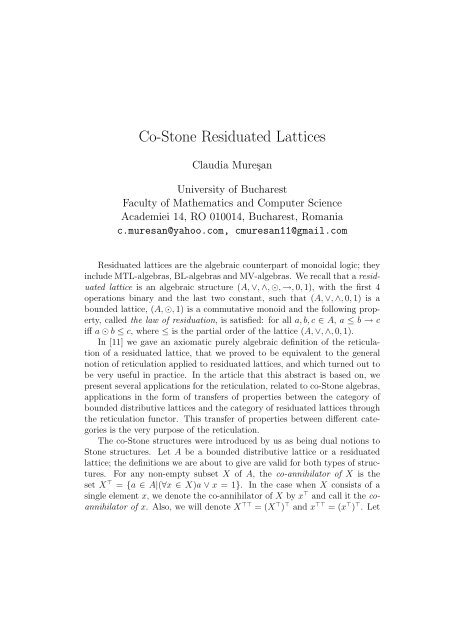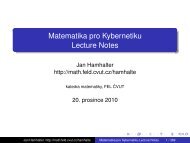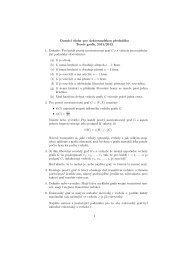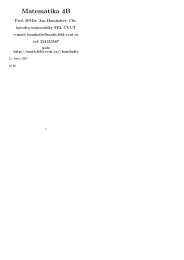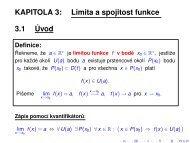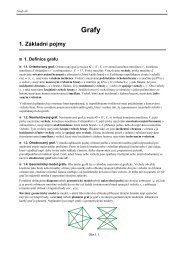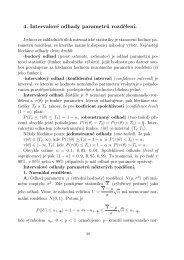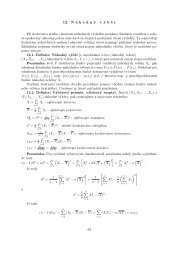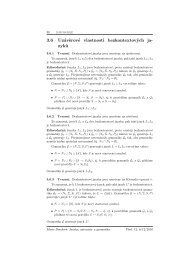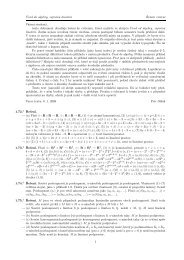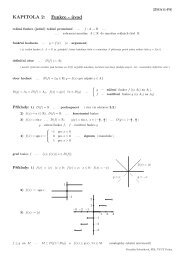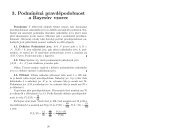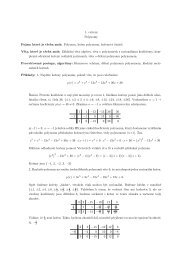Co-Stone Residuated Lattices
Co-Stone Residuated Lattices
Co-Stone Residuated Lattices
You also want an ePaper? Increase the reach of your titles
YUMPU automatically turns print PDFs into web optimized ePapers that Google loves.
<strong>Co</strong>-<strong>Stone</strong> <strong>Residuated</strong> <strong>Lattices</strong><br />
Claudia Mure¸san<br />
University of Bucharest<br />
Faculty of Mathematics and <strong>Co</strong>mputer Science<br />
Academiei 14, RO 010014, Bucharest, Romania<br />
c.muresan@yahoo.com, cmuresan11@gmail.com<br />
<strong>Residuated</strong> lattices are the algebraic counterpart of monoidal logic; they<br />
include MTL-algebras, BL-algebras and MV-algebras. We recall that a residuated<br />
lattice is an algebraic structure (A, ∨, ∧, ⊙, →, 0, 1), with the first 4<br />
operations binary and the last two constant, such that (A, ∨, ∧, 0, 1) is a<br />
bounded lattice, (A, ⊙, 1) is a commutative monoid and the following property,<br />
called the law of residuation, is satisfied: for all a, b, c ∈ A, a ≤ b → c<br />
iff a ⊙ b ≤ c, where ≤ is the partial order of the lattice (A, ∨, ∧, 0, 1).<br />
In [11] we gave an axiomatic purely algebraic definition of the reticulation<br />
of a residuated lattice, that we proved to be equivalent to the general<br />
notion of reticulation applied to residuated lattices, and which turned out to<br />
be very useful in practice. In the article that this abstract is based on, we<br />
present several applications for the reticulation, related to co-<strong>Stone</strong> algebras,<br />
applications in the form of transfers of properties between the category of<br />
bounded distributive lattices and the category of residuated lattices through<br />
the reticulation functor. This transfer of properties between different categories<br />
is the very purpose of the reticulation.<br />
The co-<strong>Stone</strong> structures were introduced by us as being dual notions to<br />
<strong>Stone</strong> structures. Let A be a bounded distributive lattice or a residuated<br />
lattice; the definitions we are about to give are valid for both types of structures.<br />
For any non-empty subset X of A, the co-annihilator of X is the<br />
set X ⊤ = {a ∈ A|(∀x ∈ X)a ∨ x = 1}. In the case when X consists of a<br />
single element x, we denote the co-annihilator of X by x ⊤ and call it the coannihilator<br />
of x. Also, we will denote X ⊤⊤ = (X ⊤ ) ⊤ and x ⊤⊤ = (x ⊤ ) ⊤ . Let
us remark that, for A a bounded distributive lattice or a residuated lattice<br />
and for any X ⊆ A, X ⊤ is a filter of A. We will denote the Boolean center<br />
of a bounded distributive lattice or a residuated lattice A by B(A).<br />
Definition Let A be a bounded distributive lattice or a residuated lattice.<br />
Then A is said to be co-<strong>Stone</strong> (respectively strongly co-<strong>Stone</strong>) iff, for all<br />
x ∈ A (respectively all X ⊆ A), there exists an element e ∈ B(A) such that<br />
x ⊤ =< e > (respectively X ⊤ =< e >).<br />
<strong>Co</strong>ncerning co-<strong>Stone</strong> and strongly co-<strong>Stone</strong> structures (by structure we<br />
mean here bounded distributive lattice or residuated lattice), the first question<br />
that arises is whether they exist. Naturally, any strongly co-<strong>Stone</strong> structure<br />
is co-<strong>Stone</strong> and any complete co-<strong>Stone</strong> structure is strongly co-<strong>Stone</strong>.<br />
The answer to the question above is given by the fact that the trivial structure<br />
is strongly co-<strong>Stone</strong> and, moreover, any chain is strongly co-<strong>Stone</strong>, because<br />
a chain A clearly has all co-annihilators equal to {1} =< 1 >, except for 1 ⊤ ,<br />
which is equal to A =< 0 >.<br />
We prove the fact that a residuated lattice is co-<strong>Stone</strong> iff its reticulation<br />
is co-<strong>Stone</strong> and the same is valid for strongly co-<strong>Stone</strong> structures, then we<br />
obtain a structure theorem for m-co-<strong>Stone</strong> residuated lattices, by transferring<br />
through the reticulation a known characterization of m-co-<strong>Stone</strong> bounded<br />
distributive lattices to residuated lattices. This is the first major example<br />
of a result that can be transferred through the reticulation functor from<br />
the category of bounded distributive lattices to the category of residuated<br />
lattices. It also permits us to state that a residuated lattice is m-co-<strong>Stone</strong><br />
iff its reticulation is m-co-<strong>Stone</strong>. Here is the characterization of m-co-<strong>Stone</strong><br />
residuated lattices that we are referring to:<br />
Theorem Let m be an infinite cardinal. Then the following are equivalent:<br />
(I) for each subset X of A with |X| ≤ m, there exists an element e ∈ B(A)<br />
such that X ⊤ =< e >;<br />
(II) A is a co-<strong>Stone</strong> residuated lattice and B(A) is an m-complete Boolean<br />
algebra;<br />
(III) A⊤⊤ = {a ⊤⊤ |a ∈ A} is an m-complete Boolean sublattice of the lattice<br />
of filters of A;<br />
2
(IV) for all a, b ∈ A, (a ∨ b) ⊤ = a ⊤ ∧ b ⊤ and, for each subset X of A with<br />
|X| ≤ m, there exists an element x ∈ A such that X ⊤⊤ = x ⊤ ;<br />
(V) for each subset X of A with |X| ≤ m, X ⊤ ∨ X ⊤⊤ = A.<br />
We bring an argument for our choice of the definition of the co-<strong>Stone</strong><br />
structures over another definition for them that can be found in mathematical<br />
literature, for instance in [5]: the fact that the notion with our definition is<br />
transferrable through the reticulation (while the alternate one is not and does<br />
not coincide with ours).<br />
We then define the strongly co-<strong>Stone</strong> hull of a residuated lattice, in accordance<br />
with its definition for MV-algebras from [7] and for bounded distributive<br />
lattices from [6], show that it is preserved by the reticulation functor and<br />
exemplify its calculation for a finite residuated lattice. For proving that the<br />
reticulation functor for residuated lattices preserves the strongly co-<strong>Stone</strong><br />
hull we are using the fact that it preserves inductive limits, that we proved<br />
in [13].<br />
References<br />
[1] Balbes, R., and Dwinger, P.: Distributive <strong>Lattices</strong>. University of Missouri<br />
Press, <strong>Co</strong>lumbia, Missouri, 1974.<br />
[2] Belluce, L. P.: Semisimple Algebras of Infinite Valued Logic and Bold<br />
Fuzzy Set Theory. Can. J. Math. 38, No. 6 (1986), 1356–1379.<br />
[3] Belluce, L. P.: Spectral Spaces and Non-commutative Rings. <strong>Co</strong>mm.<br />
Algebra 19 (1991), 1855–1865.<br />
[4] Bu¸sneag, D.: Categories of Algebraic Logic. Editura Academiei Române,<br />
Bucure¸sti, 2006.<br />
[5] Cignoli, R.: Free Algebras in Varieties of <strong>Stone</strong>an <strong>Residuated</strong> <strong>Lattices</strong>.<br />
Soft <strong>Co</strong>mputing 12 (2008), 315–320.<br />
[6] Davey, B. A.: m-<strong>Stone</strong> <strong>Lattices</strong>. Can. J. Math. 24, No. 6 (1972), 1027–<br />
1032.<br />
3
[7] Di Nola, A., and Georgescu, G.: Projective Limits of MV-spaces. Order<br />
13 (1996), 391–398.<br />
[8] Georgescu, G.: The Reticulation of a Quantale. Rev. Roum. Math.<br />
Pures Appl. 40, No. 7-8 (1995), 619–631.<br />
[9] Leu¸stean, L.: The Prime and Maximal Spectra and the Reticulation of<br />
BL-algebras. Central European Journal of Mathematics 1, No. 3 (2003),<br />
382–397.<br />
[10] Leu¸stean, L.: Representations of Many-valued Algebras. Ph. D. Thesis,<br />
University of Bucharest, 2004.<br />
[11] Mure¸san, C.: The Reticulation of a <strong>Residuated</strong> Lattice. Bull. Math.<br />
Soc. Sci. Math. Roumanie 51 (99), No. 1 (2008), 47–65.<br />
[12] Mure¸san, C.: Characterization of the Reticulation of a <strong>Residuated</strong> Lattice.<br />
Journal of Multiple-valued Logic and Soft <strong>Co</strong>mputing, accepted.<br />
[13] Mure¸san, C.: Further Functorial Properties of the Reticulation. Journal<br />
of Multiple-valued Logic and Soft <strong>Co</strong>mputing, accepted.<br />
[14] Simmons, H.: Reticulated Rings. J. Algebra 66 (1980), 169–192.<br />
4


